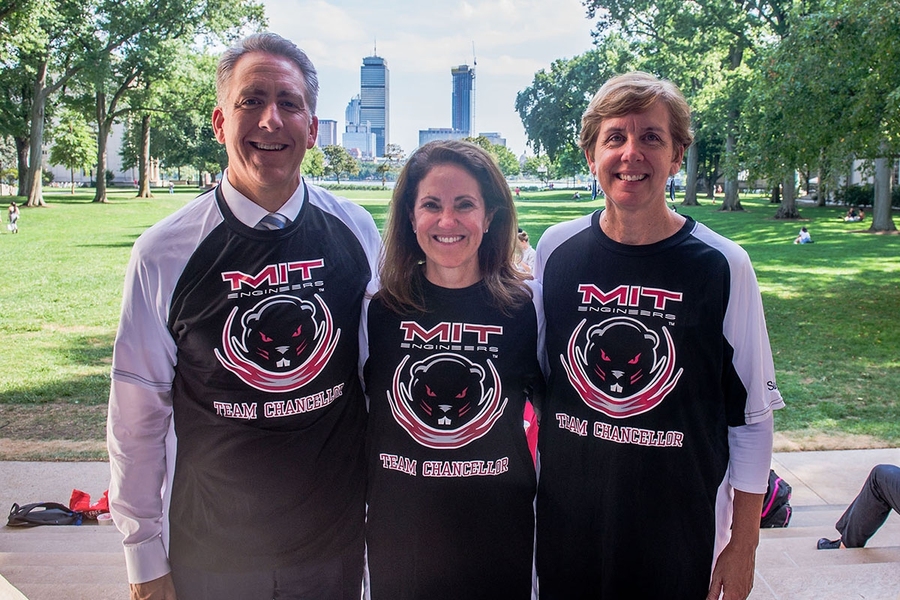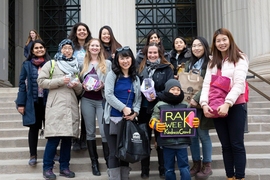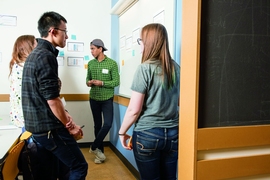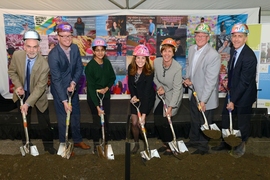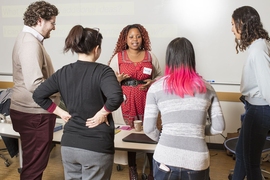Vice Chancellor for Undergraduate and Graduate Education Ian A. Waitz is a key player on “Team Chancellor.” Along with Chancellor Cynthia Barnhart and Vice President and Dean for Student Life Suzy Nelson, the trio is focused on working with students, faculty, and staff to enhance undergraduate and graduate student life and learning.
On certain occasions (such as Random Acts of Kindness Week events, ice cream socials, and other gatherings) they don sports jerseys with their names and numbers printed across the back. With his second year in the vice chancellor role now complete, Waitz spoke about his office’s work and how he approaches problem-solving.
Q: You have made some recent progress on enhancing the graduate student experience, especialy in tackling the financial insecurity that some students face. Can you talk about that and other ways you're working on behalf of MIT’s graduate students?
A: Together with many partners across campus, we’re taking a holistic look at the overall graduate student experience here at MIT. Professional development is high on that list, as are addressing the unique financial needs of graduate students, building community, issues around diversity and inclusion, among other issues. We created a Graduate Student Roadmap that lays the foundation for change, and we are working to implement these initiatives one by one.
One issue that has come to the fore recently is financial insecurity. To their credit, the Graduate Student Council (GSC) made it a priority to bring increased attention to the issue this academic year. Their partnership has been vital. With their insights, and informed by the 2018 Academic Climate Survey and other data, we’ve secured a commitment from each school to implement policies and practices to help reduce financial insecurity among graduate students. For now, we’re focusing on doctoral students with 9-month stipends or who have non-resident status. There’s more work to be done, but this is a significant step in the right direction, and we’re grateful to the school deans, department graduate administrators, and graduate student leaders for their efforts to make it happen.
Along the same lines, we recognize that students with families have higher expenses and unique needs. We established a Graduate Family Support Working Group to analyze the issues that impact this cohort. This year, the group has been cataloging and benchmarking needs, in addition to an external scan of our peers, with the goal of providing an interim report for community feedback this summer.
One other area — among many! — we are working on now is graduate advising. Institutional Research did a meta-analysis of this issue for us. Not surprisingly, it revealed that the graduate student/advisor relationship is the biggest single factor that correlates with student satisfaction. If the fit is good, it can be a lifelong, positive mentoring relationship. If it’s not, it can make life very difficult for grad students and even affect their career interests and aspirations. Given that the stakes are high, it is important to do our very best with it.
We are fortunate that senior leadership, deans, department heads, and so many others have been and are now even more engaged with addressing graduate advising issues, too. Efforts like GradSAGE, the graduate student advisory group in the school of engineering, is notable and has recently launched a pilot to ask faculty members in the departments of Aeronautics and Astronautics and Electrical Engineering and Computer Science to develop and post their personal advising philosophy statements online in an effort to help make the advisor/advisee matchmaking process more transparent.
We are also launching a questionnaire to departments to enable us to document existing graduate advising practices across the Institute and identify needs. The questions are generally focused on the advisor selection process, resources for students, feedback to advisors, and training in advising/mentoring. We know students are very interested in the advising feedback loop.
In addition, a team from our office, the Office of Graduate Education, the Teaching and Learning Laboratory, and MindHandHeart is working with professor of chemical engineering Paula Hammond, who was recently charged by School of Engineering Dean Anantha Chandrakasan to develop and run a pilot series of workshops aimed to help faculty understand best practices in managing and mentoring in an academic lab. Ultimately, we hope to scale this up to other departments in the School of Engineering, and then to the Institute level.
Q: One of the initial charges of your office was to improve the undergraduate academic experience. That’s a broad mandate. What specifically have you been working on?
A: Our focus for undergraduates has been on community engagement and building consensus around a core set of needs. Thanks in no small part to student input from the Designing the First-Year Experience class, we now have four overarching needs to guide us: more support for exploring and choosing a major; better advising; more inspiring experiences that cultivate a love of learning; and greater flexibility and/or fewer requirements to enable the other things to happen.
Our most prominent efforts in response to these needs are two phases of an educational experiment approved by the Committee on the Undergraduate Program to enable greater exploration in the first year. Phase One, for students who entered in fall 2018, allows them to take up to three science core GIRs as pass/no record (P/NR) after the first semester. This has allowed many students to reframe their approach to the first semester, namely to spend more time exploring interests (including taking GIRs and other courses) and adjusting to college life.
Phase One data indicated that students are, in fact, exploring more. We’ve also learned that incoming students tend to fall into three buckets in terms of how they explore academic fields. Some arrive here with a specific major in mind, some are considering a few options, and the remainder don’t yet have a clear sense of a major and hope to discover new interests. While Phase One enabled students to deeply explore a few departments, it seemed to have less impact for students who wanted to discover their passions from among a broader range of possibilities.
The Phase Two experiment, for students entering this coming fall, aims to address the needs of this third group of students through a category of First-Year Discovery Subjects. These are 1-3 units and offer students a brief taste of departments across the Institute. They’ll be counted under a separate 9-unit limit, outside the normal first-year credit limit. We hope students who take one or more of these subjects can discover topics that spark their curiosity enough to pursue more deeply through majors, minors, HASS concentrations, and more.
Another key aspect of Phase Two is that students entering in fall 2019 will not be offered Early Sophomore Standing (ESS), which enables students to declare a major early, get an advisor in that major, and exceed the first-year spring credit limit. ESS tends to favor students with a lot of unrestricted elective credit from advanced placement and international baccalaureate exams; it resulted in nearly half the class being eligible this year. Our reasoning is that this will help address the notion that anyone should declare their major after only one semester at MIT; give every student access to advice in departments of interest; and shift the responsibility for determining how many units a student should take to the student and their advisor.
In addition to these two experiments, we have smaller efforts that address the other needs: advising and inspiration. In fall 2019, we will be piloting a “network advising” approach, where students are assigned a staff advisor in the Office of the First Year (OFY), a faculty mentor, and a student Associate Advisor. That way, OFY can handle the more mechanical and specialized advising questions, and faculty can focus on personal or goal-oriented questions. We are also working with the First-Year Learning Communities to test methods for embedding inspiring learning experiences within the first year.
Q: Your office is engaged in some very ambitious goals. Is there anything you’ve learned in the process of moving your agenda forward, or anything that has stood out to you?
A: Implementing change at MIT takes time and isn’t always easy; we get used to the status quo, and sometimes it’s hard to think outside of the box. And inevitably, there are differences of opinion that need to be ironed out. But a guiding principle I always try to come back to is, “What problem are we trying to solve, and what’s the best way to go about it?”
You can’t solve a problem unless you define and understand it fully, inside and out. And I’ve found that the best way to do that is a two-pronged approach: to gather as much data and information as you can, and to engage the community as much as possible. We rely on our students and faculty for their input, as well as other people who have a stake in the issue at hand. We’re always trying to find that sweet spot where we can respond to our students’ needs and serve them better, while considering the many variables, parameters, constraints, and other players involved.
With that in mind, one thing that stands out to me is the incredibly valuable partnerships we have built with students, particularly the Undergraduate Association (UA) and the Graduate Student Council (GSC). MIT is somewhat unique among universities in that we have a shared governance model. We have great relationships with the UA and GSC. Chancellor Barnhart, Dean Nelson, and I meet with student leaders regularly, and they are such a pleasure to work with. Many of the ideas and solutions that have bubbled up since I started in this role originated with them. And they volunteer their time even though they already have very full plates! That never ceases to amaze me. Their dedication to making MIT better for students now — and in the future — inspires me, my staff, and everyone on “Team Chancellor” every single day.
